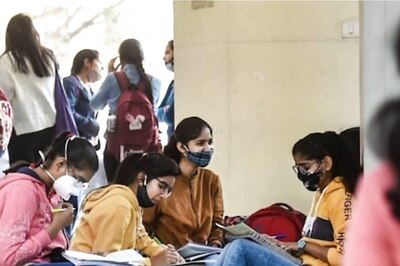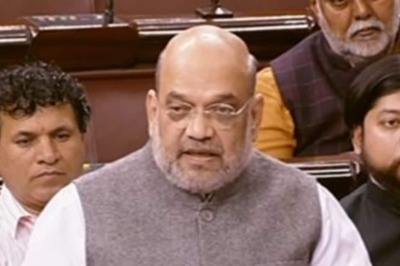
views
The novel coronavirus outbreak has affected economies and hundreds of thousands of people globally. In these times of distress, it all boils down to the three necessities of life: food, shelter, and the internet. Although the government is taking initiatives to ensure that people are able to fulfil their basic needs of food and shelter, more needs to be done to ensure that people have stable internet connections.
Imagine a world without any internet in these stressful times. Sustaining even minimal economic activity would have been impossible as there would have been no work from home, and no e-commerce. However, thanks to the availability of digital technologies, we can live our lives almost normally.
During the nationwide lockdown, digital technologies have enabled people to work remotely, order essentials through apps, attend classes online and obtain assistance in many other forms. They have not only aided people to perform daily activities, but also played a vital role in containing the spread of the virus.
For instance, the Aarogya Setu App, launched by Government of India, keeps a user informed in case they have crossed paths with someone who has tested positive. This allows timely action by the government to control the spread of the disease. The app also facilitates teleconsultation, online medicines, and doorstep lab tests. Similarly, other apps are helping spread awareness about the disease.
For example: Ministry of Health and Family Welfare launched a WhatsApp chatbot called ‘MyGov Corona Helpdesk’. This will not only help in raising awareness about the disease but will also control the spread of panic-causing news and dispel myths related to remedies. Another great example is Bione’s Microbiome test, an AI-based predictive analysis tool to provide recommendations to people to strengthen their immunity to ward off the novel coronavirus.
All of this would have not been possible if there were no digital technologies, and if there was no internet to support these technologies. Their advantages are visible across sectors such as health, banking, entertainment, education, commerce and so on. The availability of digital wallets has allowed people to perform cashless transactions and reduce the risk of spreading the deadly virus. Children are attending classes from their homes. Not to forget, there has been a drastic increase in the usage of OTTs such as Netflix, Amazon Prime, etc. The lockdown also witnessed surge in data consumption even in the rural areas.
However, not everyone is able to enjoy these benefits. There are many people, who do not have access to internet connectivity. Even though a large part of the Indian population lives in rural India, total number of internet subscribers per 100 rural population is just 27.57. Even the rural teledensity is just 57.59 %. How is this section of the population supposed to lead a normal life, given that the entire country is under lockdown?
Even in urban areas, all the citizens (especially the below poverty line citizens and people in the elderly age groups) do not have access to these technologies, making the already difficult times, even worse. The children in these affected groups are not only missing on facilities such as daily meals that they used to get in school, but are also missing on education, as they do not have access to internet services. Hence, access to these technologies and internet should not be treated as a privilege but as a right of each citizen.
But how can we provide these facilities to all the citizens, when the existing coverage, speed and quality of internet services are not up to the mark? High population density combined with low number of towers, low fiberization of towers, and low spectrum availability make it difficult to provide customers with decent quality of internet services. If we want to deliver internet connectivity to all the citizens, then it becomes indispensable that we increase our focus towards the development of telecommunications network in the country.
Though speedy implementation of NDCP 2018 could help in solving the problem, but some immediate measures are needed. As the Indian Telcos are already burdened due to hyper competition and government dues, there is a need to provide necessary support to the sector to promote the sectoral development. Rationalizing levies and taxes would go a long way in providing a necessary boost to the sector.
Apart from this, permitting active infrastructure sharing, increasing spectrum availability, and promoting tower fiberization, are some of the key measures to accelerate the development of the telecommunication sector. Through its flagship project BharatNet, the government has been trying to create necessary broadband network in rural areas, but there is a need to expedite the pace of the project. The current situation has increased the load on the telecommunication infrastructure, which might not be prepared to handle the current demand.
The entire situation makes a strong case for need to develop the digital communication and technological infrastructure in the country. A robust and reliable telecommunication network forms the foundation of the digital economy. Multiple studies have shown that investments in telecom infrastructure, increase in internet penetration, and increase in mobile penetration, all have significant impact on the GDP growth of the country. Hence, it is necessary to further build and enhance the telecommunication sector.
Development of the telecommunication sector and digital technologies would not only help us in handling such situations in a better manner but will also help in the growth of the digital economy. But apart from the development of the technology, we need to ensure that everyone, including old people and the poor start using this technology.
We don’t know by when we will be able to come out of this pandemic, whether there would be recurring episodes of similar pandemics. But one thing we know for sure is that we need to build on our technical capabilities and ensure that each and every citizen of the country can avail the benefits of digital technology for a better, more connected and prosperous India.



















Comments
0 comment